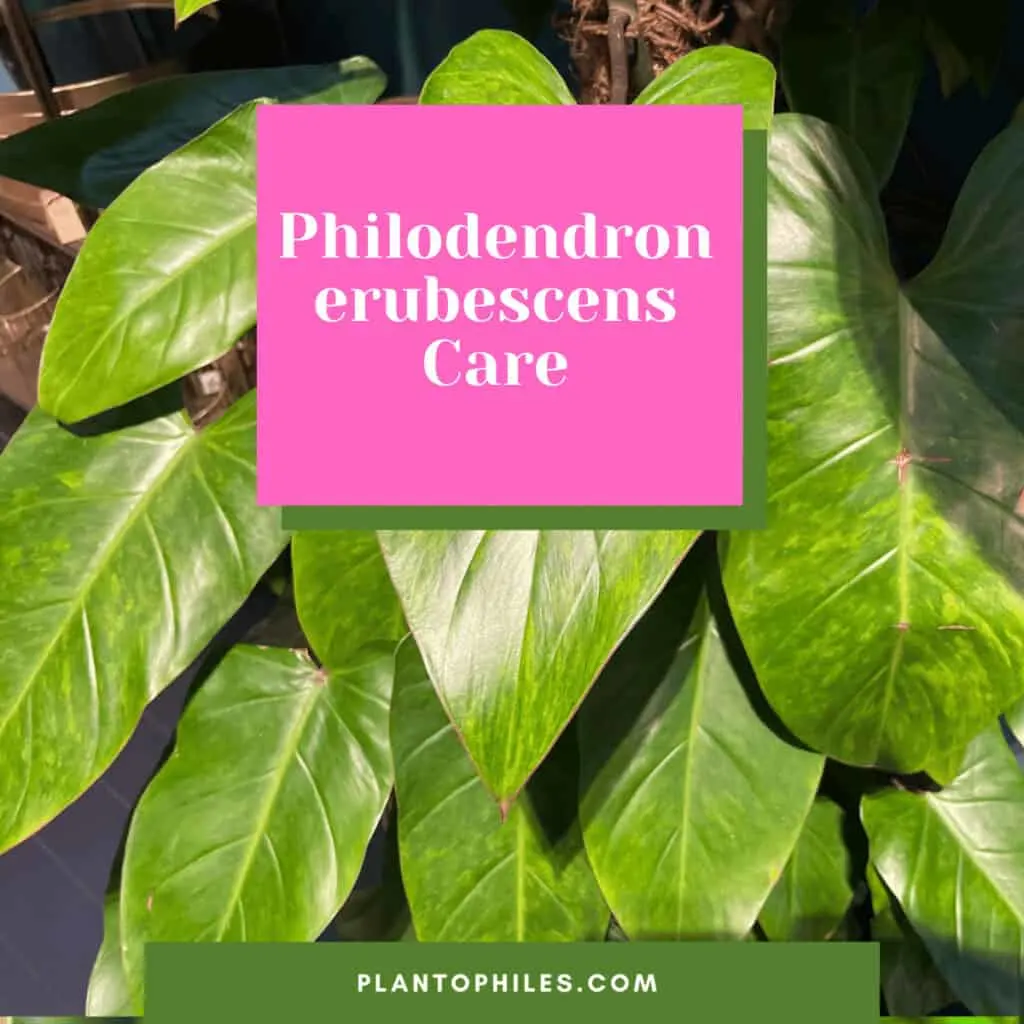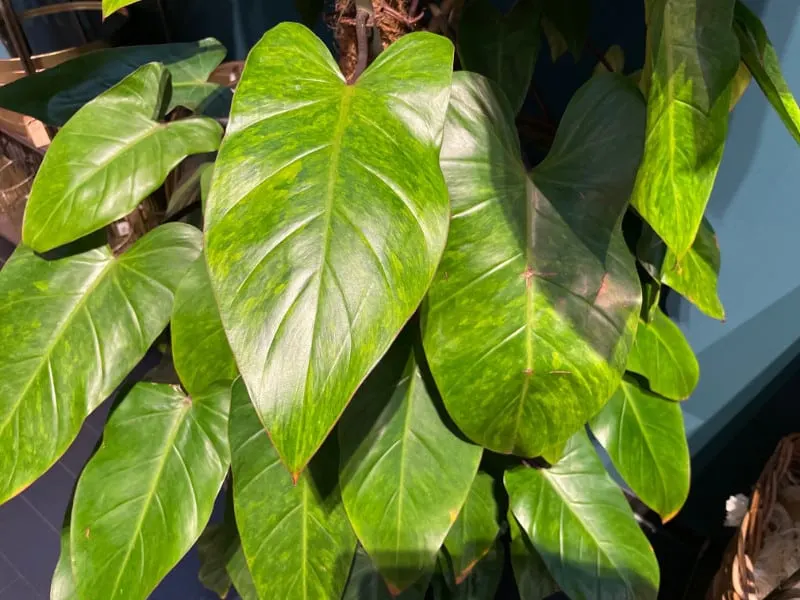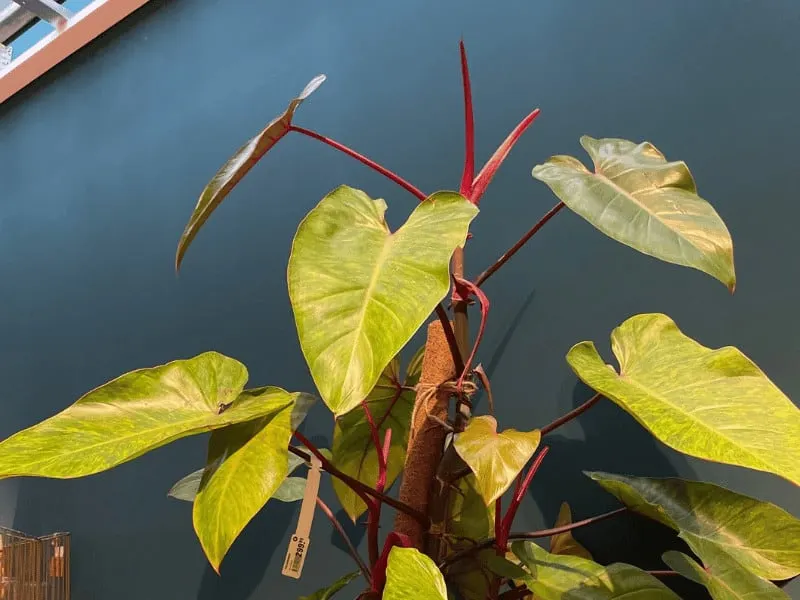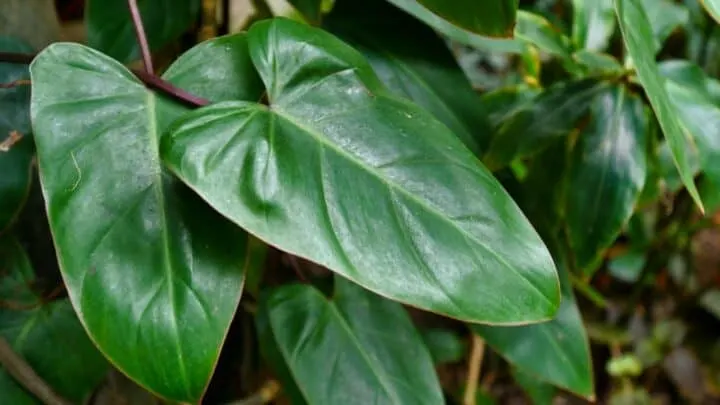The vigorous climber Philodendron erubescens has long, slender shiny green leaves with red accents. It is also called the red-leaf Philodendron, according to Clemson University. The petioles, midribs, and veins are red. It produces aerial roots that hold onto other plants and moss poles.
Compared to the Pink Princess Philodendron and its pink variegation, the erubescens new leaves are burgundy when emerging.
The Red Emerald is a blooming plant endemic to Colombia known as the blushing Philodendron. This Philodendron belongs to the Araceae family and is notable for its heart-shaped leaves and rich red blooms.
Philodendron erubescens Takeaways
| Species | Philodendron erubescens |
| Synonyms | Red-leaf Philodendron, Blushing Philodendron, Red Emerald Philodendron, Wine and Roses Philodendron, Burgundy Philodendron |
| Family | Araceae |
| Genus | Philodendron |
| Growth | Climbing, trailing |
| Height | 3.0 feet |
| Width | 1.0 foot |
| Soil | A well-draining, slightly acidic soil mixture with ample organic matter. |
| Watering | Once a week |
| Light | Bright indirect |
| Temperature | 64 to 77°F |
| Humidity | 50-80% |
| Fertilizer | Balanced fertiilizer once a month |
| Propagation | Stem cuttings |
Table of Contents
Philodendron Erubescens Care
To care for Philodendron erubescens use well-draining soil. The potting mix should be slightly acidic to neutral. They will flourish in bright indirect light. Maintain temperatures between 64 to 77 degrees Fahrenheit (18 to 25 degrees Celsius). Keep the humidity above 50%. Provide them with a balanced fertilizer with an NPK ratio of 15:15:15 once a month in spring and summer.

Blushing Philodendron Growing Guide Indoors
This is a houseplant care guide if you grow your Red Emerald indoors.
Philodendron Soil
Use well-draining soil containing peat, perlite, orchid bark, charcoal, and organic matter.
Philodendron erubescens enjoys a slightly acidic to neutral soil mix having a pH between 5.8-7.5.
Avoid very heavy or light sandy soil mix for cultivating your plant.
Heavy soil will hold a lot of water, making your Philodendron prone to root problems.
Light sandy soil will drain away from the water rapidly, and roots cannot take up the nutrients from the water.
Different ways to make the perfect soil mix for the Blushing Philodendron:
- Use 100% of sphagnum peat moss.
- Combine peat, vermiculite, and perlite in equal parts.
- Add chunky bits to the existing potting mix to make it well-draining
- Use cactus, orchid, or succulent mix if you want a store-bought soil mix. These mixes work perfectly.
Water
Water once a week.
Like several other arums, Philodendron Erubescens loves to stay in moist but not soggy soil as it can cause root rot.
Do not let the plant dry out between the waterings.
Make sure not to overwater your plant. It leads to yellow leaves and rotting roots.
Light
Provide bright indirect light. Do not expose the plant to direct sun for more than 4 hours daily as it burns the foliage.
It also grows well in partial shade to medium light.
An eastern to a western-facing window is ideal. The eastern window will provide a couple of hours of direct sun in the morning. The western window will have some hours of direct sunlight in the afternoon.
Place your plant 10 to 12 feet away from the window. (3-7.7m).
If you keep it outside, ensure it’s in the shade or moderate sun. Place the plant beneath a shade or under dappled light is a smart option.

Temperature
It will do its best to maintain the indoor temperature between 64-77°F (18-25°C). The plant will do fine in the USDA hardiness zones 10-11.
Avoid extremely low and high temperatures. Above 95 degrees Fahrenheit (35 degrees Celsius), the plant will show signs of distress.
Temperatures belong 60°F should also be avoided (16°C). Philodendrons are not frost-hardy. Temperatures below 60°F will slow down plant growth. If the temperature goes below 55 degrees Fahrenheit (12.8°C), it will harm the plant’s health.
From my experience, leaves will wilt, and the foliage and petioles will limp.
Hence avoid growing these plants outside where the temperatures drop below 50 degrees Fahrenheit (10 degrees Celsius).
Humidity
Provide a humidity of 50% or greater. It will, however, be able to endure low humidity without issue. The ideal humidity is 60-80%.
To increase the humidity:
- Put plants closely together
- Make use of a pebble tray filled with water underneath the pot
- Use a humidifier
Fertilizer
Add a balanced fertilizer with an NPK ratio of 15-15-15 or 10-10-10 once a month. Reduce it to half the recommended strength. Fertilize in the growing seasons in spring and summer. Reduce or refrain from fertilizing in autumn and winter.
If the Philodendron isn’t developing well despite obtaining optimal light, increase fertilization to once every two weeks.
A signs of insufficient nutrients is slower growth and smaller leaves.
Growth
It is a fast-growing plant. It is a climbing vining plant.
It reaches 3 to 5 feet in height (0.9-1.5m).
The foliage can get 16 inches long (40cm).
To support the vertical growth pattern, use a moss pole. This way, your plant will grow a stronger stem and larger leaves.
Pot
Use a terracotta pot or any plastic pot. Ensure drainage holes are at the bottom so excess water can drain.
Repotting
Repot yearly. The plant will grow quickly under the right conditions. It can be tough to report a mature plant already mounted on a support system. You can also replace only the top layer of soil.
Pruning
Prune it continuously to keep its size and shape in check. Prune any spindly stems to encourage them to regenerate.
Trim any diseased leaves, especially those that have become yellow or brown.
Propagate Philodendron erubescens (Propagation)
This plant can be propagated using stem cuttings.
The optimal time for propagation is during the growing season. Preferably early spring or summer.
Follow the steps below:
- Select a stem section with at least two to three leaves and 1-2 nodes
- Take a cutting about 3-7 inches long (4-18cm) using a sharp, sterilized pair of scissors or pruning shears
- Prepare a tiny pot (6 x 6 inches (15×15 cm)) with new, well-draining potting soil
- Add some water to moisten the soil
- Remove 1-2 bottom leaves so no leaf is touching the soil
- Put the plant in a hot, humid environment receiving moderate, indirect light. Protect the plant with a plastic bag or plastic container to boost humidity.
- The cutting will root within 20 to 25 days.
- Once new leaves sprout, the cuttings are sufficiently rooted
- Repot the seedlings once they produce true leaves
Blooms
Blooms from late spring to early summer. Grows deep red flowers consisting of a spathe and spadix. This is called an inflorescence. The red flower is not a flower but a spathe. A spathe is a modified leaf. The flowers are tiny and are part of the erect spadix.

Common Problems for Philodendron erubescens
Yellow Leaves
Yellow leaves are mostly caused by overwatering. It can also be due to underwatering. A third reason is pest infestation.
In addition, the location could be too dark.
Developing mold is a sign of overwatering and cold temperatures.
Brown leaf tips
Brown leaf tips can be caused by fluoride and chloride in water. Let tap water rest for at least 24 hours before watering.
Light-colored green leaves
Nutrient deficiency causes small leaf growth and light green leaves. Proper fertilization is crucial for long-lasting, robust leaves. If you don’t feed the plant for more than two months, it shows symptoms of nutritional inadequacies.
Root Rot
Root rot is a common problem with a plant sitting in overly wet or saturated soil for an extended period.
Rapidly yellowing leaves reduced development, and a decaying brown base is indications.
Take your plant from the pot and examine the condition of the roots underneath the soil level.
You’re fine to go if the roots have a yellow tint, but if they’re dark and squishy, you must act quickly.
Remove the plant and cut off the mushy brown roots.
Rinse the roots, disinfect the pot and exchange the potting soil with new soil.
Brown or Yellow Spots
Brown or yellow spots have to do with a bacterial or fungal infection. Humidity also often plays a role. Too much or too little watering can cause brown or yellow spots on the plant leaves. In addition, if plant leaves stay wet for too, it can cause fungus and bacteria to grow.
Red Emerald Pest Infestation
Pest infestations are a natural occurrence. Every grower and outdoor gardener will face this issue sooner or later. Spider Mites, Mealybugs, Thrips, Fungus Gnats, Whiteflies, and Scale are common pests.
Plant pests often suck the plant sap. They weaken the plant.
To avoid an infestation, check your plants weekly whenever you water them.
Spray with horticultural soap once a week. Use neem oil. Mix your spray using rubbing alcohol and dishwater soap.
Alternatively, you can use beneficial nematodes such as Amblyseius swirskii.
If nothing helps, use a systemic insecticide.
Tips for Growing Philodendron erubescens
- Ensure the soil’s top 2-3 inches (5.0-7.5cm) is dry between waterings to maintain the soil hydrated.
- Remember that the amount of water you supply is directly related to the quantity of light available.
- During the year’s cold season, reduce irrigations even further to simulate their much-needed dormant time.
Philodendron erubescens varieties
The most popular Philodendron erubescens varieties are:
- Philodendron Erubescens Ruby
- Philodendron Pink Princess
- Philodendron White Knight
- Philodendron White Whizard
- Philodendron White Princess
- Philodendron Erubescens Red Emerald
- Philodendron Erubescens Imperial Red
- Philodendron Black Cardinal
- Philodendron Painted Lady
- Philodendron Erubescens Green Emerald
- Philodendron Erubescens Gold
Philodendron erubescens Toxicity
Toxic to cats and dogs as well as humans. Contains insoluble calcium oxalate crystals.
Read also: Philodendron gloriosum care guide, Philodendron Burle Marx care
Frequently Asked Questions
Does Philodendron Erubescens like the direct sun?
Although the plant is said to be a tropical warm weather, it does not prefer to stay in a spot with direct sun. That is because direct sunlight burns the foliage.
How can I know if I overwatered my Philodendron Erubescens?
An overwatered Philodendron Erubescens can be easily determined by looking at the state of the foliage. If the leaves appear pale and yellow, you have overwatered your plant.
Conclusion Philodendron erubescens Growing Guide
The Philodendron erubescens grows best in bright indirect light. Provide humidity above 50%. A temperature between 64-77°F (18-25°F) is ideal. Water once a week. Fertilize once a month in spring and summer using a well-balanced fertilizer.

Daniel has been a plant enthusiast for over 20 years. He owns hundreds of houseplants and prepares for the chili growing seasons yearly with great anticipation. His favorite plants are plant species in the Araceae family, such as Monstera, Philodendron, and Anthurium. He also loves gardening and is growing hot peppers, tomatoes, and many more vegetables.


